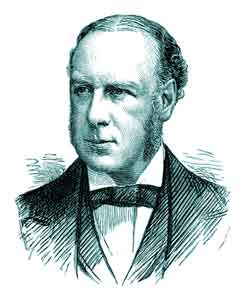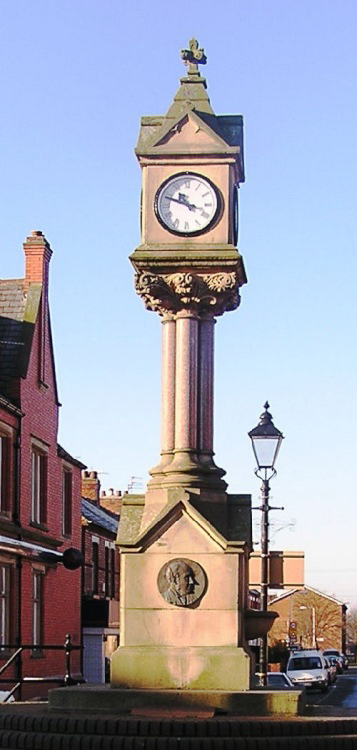Sir William Henry Houldsworth, 1st Baronet (1834–1917)
Sir William Henry Houldsworth was born on 20 August 1834 in Ardwick, Manchester, the fourth son of Henry Houldsworth and Helen Hamilton. He was baptised at St Thomas’s Church, Ardwick Green, on 30 December 1834 and was later educated at the University of St Andrews, Scotland. Upon completing his studies, he joined the family business as a partner.
In the early 1860s, Houldsworth acquired land adjacent to the Stockport Branch of the Ashton Canal in Reddish, Stockport, where he established Reddish Mill. Construction began in 1863 and concluded in 1865, with the architectural work led by A.H. Stott & Sons of Oldham, founded in 1847 by Abraham Henthorn Stott Sr. The newly formed Reddish Spinning Company, in which four Houldsworth family members held a 60% share, oversaw the development of North Mill (begun in 1870) and Middle Mill (begun in 1874). Since the 1950s, the entire site has been collectively known as Houldsworth Mill.
Beyond the mills, Houldsworth commissioned the construction of the Mechanics’ Institute and Library—now the Houldsworth Working Men’s Club—completed in 1874. All buildings in this industrial complex, including the mills and the institute, were designed by Abraham Henthorn Stott Sr.
Houldsworth also engaged the eminent architect Alfred Waterhouse RA RIBA (1830–1905) of Cross Street, Manchester, to design St Elisabeth’s Church, an adjoining rectory, and a nearby school. A model village for mill workers was constructed nearby, with houses built in a variety of sizes to reflect the residents’ roles and status within the mill. Although some of these homes have since been demolished, several examples remain on Houldsworth Street and Liverpool Street.
Alfred Waterhouse is renowned for designing prominent buildings across the UK. In Manchester, his works include the Town Hall, the Refuge Assurance Building (now the Kimpton Clocktower Hotel), and the original Owens College building, now part of the University of Manchester.

Political and Civic Contributions
From 1883 to 1906, Houldsworth served as the Conservative Member of Parliament for Manchester North West. In 1892, he represented the British government as a delegate at the European Monetary Conference in Brussels. He was succeeded as MP by Winston Churchill, then a member of the Liberal Party.
In recognition of his service, Houldsworth was created a Baronet in 1887. He later became Chairman of the Fine Cotton Spinners’ and Doublers’ Association and was awarded the honorary title of Freeman of the City of Manchester in 1905. The Victoria University of Manchester also conferred upon him an honorary Doctor of Laws (LLD). Following his retirement from political life in 1906, he moved permanently to his estate near Kilmarnock, Scotland, where he died on 18 April 1917.
In the early 1860s, Houldsworth acquired land adjacent to the Stockport Branch of the Ashton Canal in Reddish, Stockport, where he established Reddish Mill. Construction began in 1863 and concluded in 1865, with the architectural work led by A.H. Stott & Sons of Oldham, founded in 1847 by Abraham Henthorn Stott Sr. The newly formed Reddish Spinning Company, in which four Houldsworth family members held a 60% share, oversaw the development of North Mill (begun in 1870) and Middle Mill (begun in 1874). Since the 1950s, the entire site has been collectively known as Houldsworth Mill.
Beyond the mills, Houldsworth commissioned the construction of the Mechanics’ Institute and Library—now the Houldsworth Working Men’s Club—completed in 1874. All buildings in this industrial complex, including the mills and the institute, were designed by Abraham Henthorn Stott Sr.
Houldsworth also engaged the eminent architect Alfred Waterhouse RA RIBA (1830–1905) of Cross Street, Manchester, to design St Elisabeth’s Church, an adjoining rectory, and a nearby school. A model village for mill workers was constructed nearby, with houses built in a variety of sizes to reflect the residents’ roles and status within the mill. Although some of these homes have since been demolished, several examples remain on Houldsworth Street and Liverpool Street.
Alfred Waterhouse is renowned for designing prominent buildings across the UK. In Manchester, his works include the Town Hall, the Refuge Assurance Building (now the Kimpton Clocktower Hotel), and the original Owens College building, now part of the University of Manchester.
St Elisabeth’s Church
St Elisabeth’s Church, located on Bedford Street, Reddish, was commissioned and fully funded by William Houldsworth. Constructed between 1881 and 1883 and consecrated in 1883, it was named in honour of his wife, Elisabeth Graham Crum. The church reflects Houldsworth’s Anglo-Catholic beliefs and is part of the Church of England. It is designated a Grade I listed building (List Entry No. 1356851).
Designed in the Neo-Gothic style by Alfred Waterhouse, the church was constructed using locally sourced materials: bricks from Openshaw and decorative stone from Wrexham. Inside, polished granite columns line the nave and support the roof structure. The adjoining bell tower houses a peal of eight bells.
A particularly notable anecdote from the church’s construction involves the delivery of the granite columns. Transported via the Ashton Canal and then the Stockport Branch Canal, the columns were unloaded at Houldsworth Mill Wharf. Owing to their enormous weight, elephants were borrowed from Belle Vue Zoo in Gorton to haul the columns from the wharf to the church site—an extraordinary feat that remains part of local lore.
Today, the church sits within a designated conservation area that includes Houldsworth and Broadstone Mills, the former Mechanics’ Institute (now the Working Men’s Club), surviving worker housing from the model village, and a disused stretch of the Stockport Branch Canal with historical features such as Grey Horse Wharf, Grey Horse Bridge, and the Grey Horse Hotel.
In the early 1860s, Houldsworth acquired land adjacent to the Stockport Branch of the Ashton Canal in Reddish, Stockport, where he established Reddish Mill. Construction began in 1863 and concluded in 1865, with the architectural work led by A.H. Stott & Sons of Oldham, founded in 1847 by Abraham Henthorn Stott Sr. The newly formed Reddish Spinning Company, in which four Houldsworth family members held a 60% share, oversaw the development of North Mill (begun in 1870) and Middle Mill (begun in 1874). Since the 1950s, the entire site has been collectively known as Houldsworth Mill.
Beyond the mills, Houldsworth commissioned the construction of the Mechanics’ Institute and Library—now the Houldsworth Working Men’s Club—completed in 1874. All buildings in this industrial complex, including the mills and the institute, were designed by Abraham Henthorn Stott Sr.
Houldsworth also engaged the eminent architect Alfred Waterhouse RA RIBA (1830–1905) of Cross Street, Manchester, to design St Elisabeth’s Church, an adjoining rectory, and a nearby school. A model village for mill workers was constructed nearby, with houses built in a variety of sizes to reflect the residents’ roles and status within the mill. Although some of these homes have since been demolished, several examples remain on Houldsworth Street and Liverpool Street.
Alfred Waterhouse is renowned for designing prominent buildings across the UK. In Manchester, his works include the Town Hall, the Refuge Assurance Building (now the Kimpton Clocktower Hotel), and the original Owens College building, now part of the University of Manchester.
Memorial in Houldsworth Square

A public memorial to Sir William Houldsworth was unveiled on 11 September 1920 in Houldsworth Square, Reddish. The structure was designed and constructed by J & H Patterson of Manchester and was funded through public subscription.
The monument, built from sandstone and pink granite, features four clock faces supported by granite columns. It incorporates a bronze portrait plaque, a commemorative inscription, and a drinking fountain. Originally, animal drinking troughs were also included, but have since been removed.
In 1986, as part of a community improvement scheme, the memorial was relocated to the centre of a raised, brick-paved area complete with public seating.
In the early 1860s, Houldsworth acquired land adjacent to the Stockport Branch of the Ashton Canal in Reddish, Stockport, where he established Reddish Mill. Construction began in 1863 and concluded in 1865, with the architectural work led by A.H. Stott & Sons of Oldham, founded in 1847 by Abraham Henthorn Stott Sr. The newly formed Reddish Spinning Company, in which four Houldsworth family members held a 60% share, oversaw the development of North Mill (begun in 1870) and Middle Mill (begun in 1874). Since the 1950s, the entire site has been collectively known as Houldsworth Mill.
Beyond the mills, Houldsworth commissioned the construction of the Mechanics’ Institute and Library—now the Houldsworth Working Men’s Club—completed in 1874. All buildings in this industrial complex, including the mills and the institute, were designed by Abraham Henthorn Stott Sr.
Houldsworth also engaged the eminent architect Alfred Waterhouse RA RIBA (1830–1905) of Cross Street, Manchester, to design St Elisabeth’s Church, an adjoining rectory, and a nearby school. A model village for mill workers was constructed nearby, with houses built in a variety of sizes to reflect the residents’ roles and status within the mill. Although some of these homes have since been demolished, several examples remain on Houldsworth Street and Liverpool Street.
Alfred Waterhouse is renowned for designing prominent buildings across the UK. In Manchester, his works include the Town Hall, the Refuge Assurance Building (now the Kimpton Clocktower Hotel), and the original Owens College building, now part of the University of Manchester.
